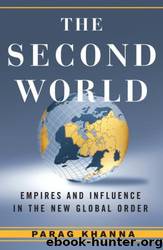The Second World: Empires and Influence in the New Global Order by Parag Khanna

Author:Parag Khanna [Khanna, Parag]
Language: eng
Format: epub
Tags: Geopolitics
ISBN: 9781400065080
Publisher: Random House
Published: 2008-01-01T15:00:00+00:00
Much of the Arab world’s fortune rests on the Gulf’s wealthiest monarchy, Saudi Arabia. Strategically located between the Red Sea and Persian Gulf, it has the world’s largest oil reserves, and buttressed by replenished coffers, the kingdom now proactively mediates in Lebanon, Iraq, and in the Arab-Israeli dispute, with Egypt and Jordan as secondary partners. Even with the largest stock market in the region, Saudis have been known to drive overnight through the desert to take advantage of IPOs in Dubai and Doha. They have started to launch major hedge funds and to pool their investments and deposit them around the region. Saudi royals also own the region’s major progressive newspapers and satellite TV stations such as Al Arabiya and are beginning to finance economic diversification and job creation to convert the Arab youth bulge from threat to opportunity.14
Saudi Arabia could be praised for the constant calibration it maintains among OPEC diplomacy, the heavy-handed demands of the United States, constantly stinging public opinion, and internal security threats. Saudi Arabia, Bahrain, and Qatar together account for close to 70 percent of OPEC oil production, and the Saudi Abqaiq refinery and Ras Tanura terminal pump 10 percent of the world’s daily oil consumption. To protect its economic heart, it has built an impenetrable energy infrastructure run by professional elites (which largely exclude members of the royal family)—which Al-Qaeda nonetheless tried to destroy with a suicide attack on the Abqaiq perimeter in 2006.
But oil price volatility, whether from political instability or supply disruptions, is the economic equivalent of an ulcer, a painful nuisance that weakens the entire body and can potentially be fatal.15 Energy consumers are eager for Saudi oil but are grievously concerned about the dysfunctional family that controls it. From petty chiefs in central Arabia, the al-Saud ascended the tribal ranks through a 1744 alliance with Mohammed ibn Abd al-Wahhab, whose religious authority bestowed credibility on Mohammed ibn Saud, a forefather of Prince Abdul Aziz ibn Saud, who marched through the fortress gate of Riyadh in 1902 and secured control of the nation. The Saudi flag depicts the might of the Saudi sword and Koranic verses symbolizing Wahhabi fervor—the twin elements defining the state. Since the anti-Soviet jihad in Afghanistan, Saudi Arabia has been second to none in bankrolling Islamic radicalism from Pakistan to Indonesia, spending that was once considered essential to its Islamic credibility. While Egypt and Jordan expelled radicals in the 1970s, Saudi Arabia accepted them as teachers and pushed Islamism as an alternative to Arabism. More recently, thousands of Saudi jihadists have poured into Iraq to fight the American occupation.
The Wahhabist establishment is locked in a power struggle with the al-Saud rulers as well. America’s cozy alliance with the royal family appalled Wahhabist clerics, who called on the likes of Osama bin Laden to resist not only the Soviet occupation of Afghanistan but also Arabia’s own occupation by Western infidels, spawning a new generation of radicals that spread like cancer cells on the Arab body politic. In this
Download
This site does not store any files on its server. We only index and link to content provided by other sites. Please contact the content providers to delete copyright contents if any and email us, we'll remove relevant links or contents immediately.
| Anthropology | Archaeology |
| Philosophy | Politics & Government |
| Social Sciences | Sociology |
| Women's Studies |
The Secret History by Donna Tartt(18728)
The Social Justice Warrior Handbook by Lisa De Pasquale(12073)
Thirteen Reasons Why by Jay Asher(8725)
This Is How You Lose Her by Junot Diaz(6694)
Weapons of Math Destruction by Cathy O'Neil(6077)
Zero to One by Peter Thiel(5629)
Beartown by Fredrik Backman(5538)
The Myth of the Strong Leader by Archie Brown(5366)
The Fire Next Time by James Baldwin(5192)
How Democracies Die by Steven Levitsky & Daniel Ziblatt(5090)
Promise Me, Dad by Joe Biden(5032)
Stone's Rules by Roger Stone(4984)
100 Deadly Skills by Clint Emerson(4790)
A Higher Loyalty: Truth, Lies, and Leadership by James Comey(4777)
Rise and Kill First by Ronen Bergman(4647)
Secrecy World by Jake Bernstein(4588)
The David Icke Guide to the Global Conspiracy (and how to end it) by David Icke(4545)
The Farm by Tom Rob Smith(4401)
The Doomsday Machine by Daniel Ellsberg(4371)
